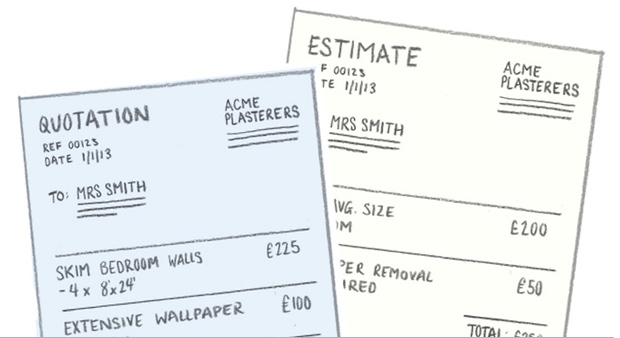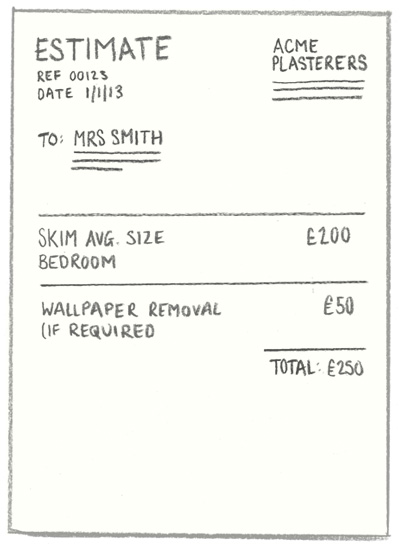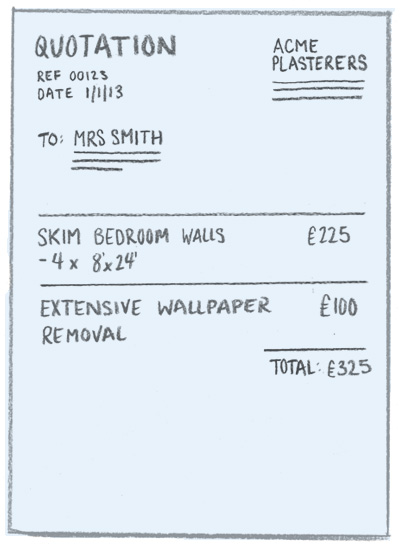Should you be sending quotes or working out estimates? Providing a fixed quotation for the cost of work or estimating all the costs? Estimates vs. Quotes – what’s the difference and which should you use…?

Odds are that as a tradesperson or small business, you spend a good deal of your valuable time writing out estimates or quotes for potential new customers.
However, there can be a lot of confusion between the two.
Contrary to what you might think, there is a world of difference between providing a quote and giving an estimate.
So, the question is: Do you know the important differences between an estimate and a quote?
Quotes vs. estimates explained
For small businesses which provide any kind of service (rather than a set price product as shops do) providing customers with an idea of what they can expect to pay for a particular job is a fact of life.
It can be a time-consuming, thankless job – especially if you’re not all that comfortable with putting pen to paper in the first place.
Understanding the difference between quotes and estimates, using the right one at the right time and making sure they have all the necessary information is critical.
We’ve written this simple, easy to understand guide to estimates vs. quotes to help you out – here’s what you’ll learn:
- What the differences are
- When to use an estimate and when to give a quote
- Why it matters
- Important details you need to include
You’ll also find the answers to the most frequently asked questions about estimates and quotes.
What’s the difference between an estimate and a quote?
The first thing to understand about quotes and estimates is that they are NOT just two different names for the same thing. Estimates and quotes each have distinct uses, benefits & disadvantages. Knowing these is key to avoiding problems that can cost you time, customer goodwill and even money.
Let’s look at estimates, first:
What’s an Estimate?
An estimate is basically a ‘guesstimate’ or rough, educated guess based on what a job MAY cost. Often it is supplied either before you know all the details of a particular piece of work (such as during an initial call from a prospective new customer) or during a site visit.
Estimates are your first thoughts on costs and can change drastically when you get further information, when unexpected complications crop up during the work or the scope of what you have been asked to do increases.
Key point: An estimate is an informal idea of price based on limited information. Consider it a starting point in terms of costs, which can go up (or down). Estimates CANNOT be used as a legal standpoint for price.
For example, let’s imagine that you’ve been asked to plaster an average size bedroom.
Mrs. Smith calls to ask about the cost of skimming her spare bedroom. She doesn’t have exact measurements but says it’s ‘average sized’. In addition, she mentions that there’s still some old wallpaper in place that needs removing.
Hence your estimate might look like this:

What’s a Quote?
A quote (or quotation) is an exact price for the job being offered. As such it is fixed and CANNOT be changed once it has been accepted by the customer (unless the customer changes the amount/type of work required or you discover something completely outside of the scope of what was agreed).
Quotes are only issued after an onsite visit or where you are confident that you have established exactly what is needed.
Key point: It’s important to remember that quotes are presented formally and represent a contract between you and the customer. As such they can be used as legal standpoints for price should a dispute arise.
Understandably, quotes give customers peace of mind; safe in the knowledge that they know exactly how much the work will cost before the job begins.
In our example with Mrs. Smith, following a visit to her home, you might have discovered that her spare bedroom is larger than average and that there is a substantial amount of old wallpaper that will take a bit longer to remove that you initially thought.
As such, you can see from the example below that your written quote has more detail and is a much more accurate reflection of the true cost of the work needed (in this case adding another £75 to the price) :

Estimate or Quote? Key Points to remember…
- Estimates are a rough idea of price. They should be used as an initial GUIDE PRICE ONLY.
- Quotes are legally binding and should ONLY be used when you are certain of the costs involved.
- NEVER label a written estimate as a ‘Quote’ – You can be held to the figure provided.
- ALWAYS ensure that the customer understands whether they are getting an estimate or a quote.
Frequently asked questions about estimates vs. quotes
Understanding the difference between an estimate and a quote is just the first step on the road to realising the potential of making both work harder for you. Admin and enquiries take up valuable time, so we’ve detailed some of the most commonly asked questions about estimates and quotes below. These not only expand on certain elements and why they are important but also give a few helpful suggestions too.
Should I always provide a written estimate or quote?
As the saying goes: verbal agreements aren’t worth the paper they’re written on. Estimates and quotes should always be provided in writing. If a query or problem arises later on it’s a good idea to have something in writing to fall back on – these make resolving any misunderstandings easier. Don’t forget to keep copies of all your estimates and quotes.
Is it OK to handwrite my quotes or estimates?
While handwritten documents are still acceptable you should ensure that these are both readable and professionally presented – nothing turns off a potential client faster than trying to decipher illegible scrawl on a scrap of paper. Your quotes and estimates should be a reflection of the level of professionalism your customers can expect from your services. Always use headed stationery with your business name and full contact details included. Anonymous blank paper makes customers nervous about the validity of your business.
What details should I include in my estimates or quotes?
Always make it clear whether you are providing an estimate or a quote, as in the examples above.
Since estimates are rough approximations of cost they should be reasonably clear but don’t have to be as detailed as a quote. Describe the job clearly in general terms. Estimates should always include a disclaimer that the price is subject to change depending upon a more detailed quote being prepared.
Once you have a better idea of exactly what’s involved then a detailed quote should be supplied. Be as specific as possible, including:
- The customers details and the address/location of the work to be carried out
- A reference number (if needed)
- The date
- A breakdown of the elements (including labour, materials or special costs)
- An accurate description of what is covered by the quote and (if necessary) what is not
- The total price
- Any VAT element should be detailed. Remember you can only charge VAT if you are registered for VAT with HMRC. You must show your valid VAT registration number on all documents.
Do I need to include my terms & conditions in both?
If you have formal terms and conditions drawn up always include a copy with your estimate or quote. This not only gives your customer with a very positive impression of your business being upfront and honest, it also provides them with information such as your normal payment terms, deposits required, penalties for non-payment, etc.
Do estimates and quotes both need dates?
Dating estimates and quotes helps you determine exactly when you prepared them. However, it’s also a good idea to specify the period for which your estimate or quote is valid for – Normally, this can range from 30 to 90 days after the date on the document, depending on your business or preference. Fees and costs naturally increase over time so setting a limit on how long your price is good for protects you from being caught out by old estimates or quotes which are now unrealistic.
Is your head still in a spin over quotes and estimates?
It’s easy to join the 1,000’s of small businesses that benefit from YourTradebase – the online tool that makes it simple to create (and manage) all your quotes and estimates in one place.
Why not try our completely free trial, and see for yourself?



